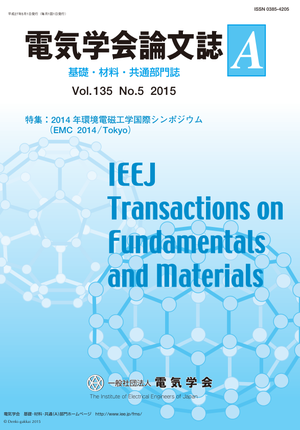水中気泡内プラズマを用いた有機フッ素化合物の分解処理とプラズマの回路モデル化による電気-化学連成シミュレーション
水中気泡内プラズマを用いた有機フッ素化合物の分解処理とプラズマの回路モデル化による電気-化学連成シミュレーション
カテゴリ: 論文誌(論文単位)
グループ名: 【A】基礎・材料・共通部門
発行日: 2015/05/01
タイトル(英語): Decomposition of Perfluoro Compounds using Plasmas within Bubbles in Water and Simulation of Decomposition System by Circuit Modeling of Plasma
著者名: 大保 勇人(東京工業大学 電気電子工学専攻),竹内 希(東京工業大学 電気電子工学専攻),安岡 康一(東京工業大学 電気電子工学専攻)
著者名(英語): Hayato Obo (Dept. of Electrical and Electronic Eng., Tokyo Institute of Technology), Nozomi Takeuchi (Dept. of Electrical and Electronic Eng., Tokyo Institute of Technology), Koichi Yasuoka (Dept. of Electrical and Electronic Eng., Tokyo Institute of Technology)
キーワード: PFOS,水処理,水中気泡内プラズマ PFOS,water treatment,plasma within a bubble
要約(英語): Perfluorooctanesulfonic acid (PFOS) is widely used for industrial and commercial products such as foam fire extinguishers and coating agents for semiconductors because of its chemical stability and physical characteristics. However, PFOS is remarkably stable and remains in the environment. Moreover, PFOS cannot be decomposed by conventional methods such as an advanced oxidation process (AOP) that involves the use of hydroxyl radicals. In this study, a reactor for generating 21 plasmas was developed to decompose PFOS rapidly and efficiently. By using the plasma treatment, 96% of PFOS in a 1-L solution was successfully decomposed in 1200 min. By using a capacitor as the ballast element, the reactor circuit efficiency became 32% (conventional) to 95% by reducing the power loss of the ballast element. Furthermore, the decomposition reaction process of PFOS by plasma was quantitatively clarified with a simulation model of the PFOS decomposition system using the plasmas.
本誌: 電気学会論文誌A(基礎・材料・共通部門誌) Vol.135 No.5 (2015) 特集:2014年環境電磁工学国際シンポジウム(EMC 2014/Tokyo)
本誌掲載ページ: 310-317 p
原稿種別: 論文/日本語
電子版へのリンク: https://www.jstage.jst.go.jp/article/ieejfms/135/5/135_310/_article/-char/ja/
受取状況を読み込めませんでした


